
A typical Tarot deck consists of seventy-eight cards. Of these, the first twenty-two are identified as the Major Arcana. The Major Arcana (which means mysteries or secrets) represent the mysteries or secrets of the universe that reflect universal law. As such, they are the most complex cards in the deck and require more diligence to understand. Each of the Major Arcana cards, which are also often called trump cards, is illustrated with specific symbols or scenarios, which are basically the same in all decks, even though they may differ thematically according to the philosophy of the designer. Each of the Major Arcana cards has a title, such as The Magician, The Empress, The Lovers, The Moon, The Tower, and so forth. They are numbered from zero—The Fool—to twenty-one—The World.
The cards in the Major Arcana represent forces beyond yourself and the limits of mundane, earthly, human existence. Depending on your personal worldview, you could think of these forces as fate, god, goddess, cosmic, karma, or your own higher self. Whichever way you choose to see the energies or entities behind the cards, they indicate that something larger, outside yourself is operating and influencing you and the issue about which you are seeking advice.
The Major Arcana cards possess many different layers. As you work with them, these layers reveal themselves. It’s a bit like digging into an archaeological site. For example, on a strictly practical level, The Empress may be a direct reference to your mother or your desire to become a mother. On the mundane or worldly level, The Magician may refer to your desire to live a more creative life, to be more creative in your work. Each individual unfolds according to his or her own inner blueprint. There’s no hurrying the process, which ultimately takes place on its own time schedule. The cycles in life show you the patterns you are following and suggest new directions. The Major Arcana can be a guide that helps us to explore universal concepts as they apply to our lives at any given moment. Let’s take a look at the cards that make up this important part of the Tarot.
Note: Since its introduction in 1909, the Rider-Waite deck (which is also sometimes called the Waite deck) has been one of the most influential and popular Tarot decks. The deck was illustrated by Pamela Colman Smith, a theatrical designer, artist, writer, and member of the occult Order of the Golden Dawn. Guided by Arthur Edward Waite, Smith produced a series of seventy-eight allegorical paintings that included storytelling images on the Minor Arcana as well as the Major Arcana cards. More than 6 million Waite Tarot decks are now in print and this classic deck is widely used to illustrate books about the Tarot—including the images found next to the Major Arcana cards in this chapter—and as a teaching tool for beginning diviners.

The Fool is a fascinating figure, yet he can be an ambiguous symbol. Related to the jester or the joker of the ordinary playing deck, which is often used as the wild card, he seems beyond ordinary cares and concerns.
Ordinarily, The Fool is shown as a person full of confidence—often the confidence of youth—and trust in the beneficence of the universe. He symbolizes that blind leap of faith that we all must take upon entering the journey of life itself, especially if that journey is spiritual.
When The Fool appears in a reading, depending on its position in the layout, it symbolizes someone who is about to embark on a new way of life. This may involve a physical journey, moving to a new place, starting a new job, or getting married or divorced. Often, the appearance of The Fool indicates a person who is ready to start on a spiritual path, who has made peace with the need to experience absolute faith and trust in the universe. In such a case, the person has no sense of worry or fear and feels that she is protected and that everything will turn out well. The person may be consciously in touch with the intuitive realm of his or her being, or he or she may simply be naive about what the future will bring. The Fool represents a state of openness and faith that he’ll be supported in his adventure.
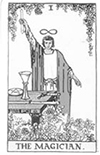
The Magician is powerful, representing worldly wisdom and the control of unseen forces that operate in human lives. A deeply complex symbol, he is usually depicted as a male figure who stands alone before an array of the traditional magician’s tools. In most decks, these are the symbols of the Minor Arcana suits, each of which corresponds to one of the four elements: a pentacle for Earth, a sword for Air, a cup for Water, and a wand for Fire. To possess knowledge of these elements is to gain mastery in the world. The Magician is in possession of knowledge that enables him to manipulate the material world through aligning it with the spiritual plane, in order to create the desired circumstances.
The appearance of The Magician in a reading indicates latent powers, yet to be taken up and brought into manifestation. Also known as The Juggler, this card suggests that everything in the universe is spread out before us, and if we learn to use them correctly we can manifest the results we desire. These are literally the basic materials of creation, and it is the task of The Magician to handle them well, to manipulate and control them for beneficent purposes. This is mental work that affects the material realm.
Thus, The Magician shows us that what we consider to be illusion is another form of reality, and what we consider to be reality can be mere illusion. This is not trickery, but a deep understanding of how we must learn to use our intellects, our intuitive abilities, our personal talents, and our practical skills in order to mediate between the two worlds, both of which affect us simultaneously.
The Magician is a card of power, for just as a mage, or true magician, stands at the center of the universe with the tools and ability to manipulate it for his purposes, so does each of us create, or re-create, our own universes within ourselves, first in our minds, and then in our manifest realities. This card tells us that our nature is one with the nature of the universe. It suggests that we have the ability to control our own lives, that we can manipulate people, things, and events—so long as we go about it the right way and for the right ends.
This card is primarily about self-development; as Tarot Arcanum One, it is the beginning of the road to spiritual enlightenment, the starting point. It does not say that we are already able to control our universes, but that we must learn what mode to use in order to gain our ends and reach our goals, whether they are spiritual or mundane.

The High Priestess is a most mysterious card, representing that which has yet to be revealed, secret knowledge, the duality of life on Earth. She symbolizes feminine spiritual power, or the Goddess from whom all life comes and to whom all returns in the ever-cycling round of earthly existence.
She is depicted as a serene-faced female figure, sometimes seated with a book or scroll on her lap, which suggests the divine law that underlies the manifest universe. The scroll or book represents the Akashic Records, the divine repository of our lives past, present, and future. Sometimes, she is standing, holding a staff and pointing toward an unseen object in the distance, another indication of something yet to be revealed.
On her breast, The High Priestess wears a cross, symbolic of the four elements—Fire, Earth, Air, and Water—held in balance. She wears a crown, usually a crescent, the horns of the Moon, or a variant of it. In the Waite deck, between the horns sits a sphere, representative of the full Moon, while the horns echo the images of the waxing and waning Moon. The three lunar phases symbolize the three stages of womanhood: maiden, mother, crone.
When The High Priestess appears, she indicates that something hidden, or interior, is preparing to come forth or that the person needs to pay more attention to his or her inner world of dreams, imagination, and intuition. She advises you to develop awareness of the totality of yourself, the night side, so to speak, as well as the daylight personality and activities. Usually, the person is ready to accept the importance of developing this part of his or her life, but may have been holding back out of fear or inertia.
Psychologically, the underworld refers to the unconscious, or what is in the process of coming into being. In this twilight realm, of which dreams are a component, we encounter our inner selves through intuition and fantasy. The High Priestess is an image representing our potentials that have yet to be discovered and brought forth—our secret selves longing to be recognized.

The Empress is a card of beauty and creativity, the matriarch incarnate, symbolic of the Universal Mother as monarch. She represents the social concept of the feminine in the maternal role: procreation, nurturing, the security and comforts of home, and domestic harmony. The Empress is always a mature female figure, often seated on a throne. Full-breasted and sometimes pregnant, she symbolizes fruitfulness and earthly abundance. As a symbol of The Empress’s royal position, she sometimes holds a scepter and wears an imperial crown of great magnificence. In many decks, a shield or coat of arms leans against her throne, at her feet. Many decks bear the astrological symbol for Venus, which is the planet of love, beauty, desires, and pleasure—the quintessential traditional feminine symbol.
When The Empress appears, a strong feminine energy is at work. As a mother figure and representative of the traditional female role, The Empress is a creative force that works for harmony. She brings disparate things together, reconciling differences, like a mother running a household must do. This is a card of emotional control and making things work congenially toward a common social goal.
The Empress also refers to the person’s emotional and physical resources—for nurturing, healing, feeding, and supporting other people. Often, there is a situation in the person’s life where love and nurturing are required—sometimes by the person herself, sometimes by others in the environment. This card is related to the caretaking process and may refer to the way the person was mothered, for the first and most significant relationship you form is with your mother, and this relationship has a direct bearing on all subsequent relationships. Sometimes The Empress indicates that the person either had an overbearing “smother mother,” or is acting out that role.
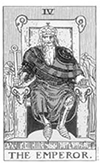
The Emperor is a figure of supreme authority, as his title suggests. He is usually shown seated on a throne, sometimes flanked by animals. In the Waite deck, these are ram’s heads, symbolic of masculine power. He wears robes over a full suit of armor, holds a scepter in the shape of the Egyptian ankh, and is crowned elaborately. His age and position of authority speak of experience and wisdom gained. Although he is depicted as a warrior, his attitude is one of kindness as the beneficent ruler of his empire.
The Emperor is the executive, or leader, who has reached the summit of authority and achieved worldly power. Thus, The Emperor is a father figure, as The Empress is a mother figure. He lays down the ideals, morals, and aspirations for the entire family to follow. He is the builder in the material world who strives to make constructions of lasting value and importance.
When The Emperor appears in a reading, look for issues related to authority. Although The Emperor represents worldly power and wisdom, he is not simply a figure who gives commands to others. His achievement is to understand that peace and security require a willingness and ability to defend it. “The price of freedom is eternal vigilance.”
The Emperor is a teacher figure, and what he teaches is the meaning of power and how to use it in this world. Though not overtly aggressive, he tells us that it is necessary sometimes to take up arms against evil forces. With The Emperor, there is no waffling about what is right and good, no rationalizing that the ends justify the means. As a protective male force, especially of the home and of domestic harmony, he personifies the ideal that what is worth having is worth fighting for.
The Emperor in a reading can also indicate issues concerning one’s biological father, or authority figures in general. He can show that the time has arrived to become the authority figure, rather than depending on others to provide protection. The Emperor often appears when the person is struggling to achieve personal independence, to overcome the inner parent tapes, to become his or her own person. The Emperor says that one must, often late in life, come to terms with what father means in his or her life, and reconcile related issues.

The Hierophant is a figure with authority and power, like The Emperor, but The Hierophant’s power is of a spiritual nature whereas The Emperor’s is temporal. Often, he is shown as a religious leader, such as the pope of Roman Catholicism. Some decks title him The Pope. He is usually seen seated on a throne, dressed in priestly raiment, crowned, and holding a scepter. His implements will vary according to the religious theme of the deck.
His scepter symbolizes the three worlds—the physical, the astral, and the etheric. His free hand is held aloft in a position of blessing. Two or three acolytes may stand before him, either as participants, supplicants, or students, deferring to his wisdom and understanding him as a representative of religious authority. The Hierophant can be seen as a teacher to those who seek the keys to the sacred mysteries. He is responsible for making spiritual decisions for others and for blessing them. Unlike The High Priestess, whose world is primarily internal and ephemeral, The Hierophant’s influence is of this world, and his spirituality can be achieved through conscious choices made on an intellectual basis.
The Hierophant suggests that the person has chosen a religion or philosophy with which to guide his or her life. In such a case, there is usually a great deal of loyalty to it, whatever the person’s concept of God may be. Sometimes the card indicates disentangling yourself from such an association.
In some organized religions, the supreme deity does not speak to the individual directly, or to the general populace. Therefore, institutionalized religion makes use of human interpreters who convey the word of God (the divine will) to their followers.
The Hierophant symbolizes any organized institution—be it religious, philosophical, educational, spiritual, or temporal—that exerts authority over its followers or participants, a kind of mind control. In such groups, there is always a person, or a group of people, who insist that their way is the only way, that theirs is the ultimate truth.
Therefore, when The Hierophant appears, the idea of choice is being presented. At this stage of your spiritual development, you are challenged to remain a follower or to break out and find your own individual truth. This card suggests that you have the opportunity—and often the desire—to choose your own road to salvation, to interpret the word of God in your own way. The Hierophant asks, will you continue to depend on an outside authority, or will you learn to think for yourself? The answer is yours alone, and there may be considerable conflict concerning the issue, but what you decide will affect the rest of your life.
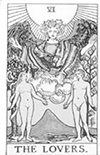
One popular image on The Lovers card shows a young couple either nude or clothed, standing apart or touching. Above them is an angel-like figure with its wings spread out over them, its hands held above their heads in a gesture of blessing. The Waite deck depicts them as Adam and Eve, standing respectively before the Tree of Eternal Life and the Tree of the Knowledge of Good and Evil. Imagery in other decks suggests choice is involved as well as the possibility of union.
Although many readers interpret this card as representing romantic love, it is allegorically a statement about union of opposites, whether those are a man and woman or inner conditions of conflict. The Lovers refers to discrimination in making choices. The male and female figures are symbols not only of human love and marriage but also of the dual nature within ourselves. When The Lovers card appears, it points to the need to heal an inner rift. Although it can herald a romantic involvement, it most often turns up when a critical life decision must be made, sometimes in connection with a love relationship. There are obstacles to be overcome, both within and without. This card suggests that you are at a crossroads. You have to consider all of the ramifications of the situation and choose carefully in order to further your own development and to accommodate the needs of others in the situation.

The Chariot is usually depicted as a strong male figure holding the reins of two Sphinx-like beasts, one black and one white. Sometimes the beasts are unicorns or other mythical creatures like Pegasus, the winged horse, or griffins. The charioteer is fully armored and carries a scepter suggesting royalty or that he is in the service of royalty. In some decks, he wears a belt and a skirt decorated with zodiacal glyphs, symbolic of time. On his shoulders are crescent moons indicating emotional factors and unconscious habit patterns that need to be changed.
The beasts pulling the chariot signify the opposing forces, which were reconciled at the stage of The Lovers and represent the person’s mastery of these opposing forces and control over inner conflicts. This card suggests that before taking on outer enemies or obstacles, it is essential to be in charge of the inner opposites and stop fighting yourself. The Chariot is a symbol for the self and its direction, as is any vehicle, such as an automobile, that appears in a dream.
When The Chariot appears, there is a need to be in control of competing forces, whether these are inner conflicts, people, or a situation in your life that requires you to take command in order to reach your goals. Like the celebrated but seldom achieved bipartisanship of government, the solution to the problem at hand is to take the middle road between the conflicting elements.
You may feel unequal to the challenge of controlling the multiple factors of a given situation, but if you choose to just go with the flow and make the best of where it takes you, you will succeed. Once you have resolved the conflict within your own mind, even if that requires considerable struggle, you will be able to move forward. To do this, you need firm resolve—self-mastery. With a strategy determined by clear thinking and a sense of purpose, you will overcome all obstacles.
Receiving The Chariot in a reading, depending on its position in the spread, is generally favorable. It indicates you have the means to triumph over all obstacles and stay the course you have set for yourself. It can also mean that assistance is on the way as a result of your own strength and determination. It may suggest you are in the process of transforming yourself and your ways of thinking and behaving in order to create a firm foundation from which to go forward and achieve your desires. At this time you are keenly aware of how to use your past experience to reach a major goal and you are in touch with deep inner resources.

Most decks depict Strength as a woman in relationship to a lion. Some writers see this as a struggle, but in many decks there does not appear to be any conflict. In fact, she seems to be controlling the lion and may even seem affectionate toward him. Although many interpreters view this card as emblematic of the struggle with one’s inner animal nature, others see it as symbolic of self-confidence and inner strength, of being in harmony with one’s instinctive nature. The figure is taming or making friends with the powerful force represented by the animal nature. Though the lion is clearly the more physically powerful of the two, the image represents human courage and willpower that masters the instinctive realm not by force, but by cooperation.
When Strength appears in a reading, you are exhibiting moral courage and fortitude. You have learned to work in harmony with your own instinctive nature, to listen to it and hear its whisperings. As in tales of the hero’s journey, the seeker often meets with animals, representative of the instinctive realm, who guide and help him on his way. Strength indicates that you have come through difficulties and learned to rely on inner strength to solve your problems.
This is a time when faith in yourself will pay off, when your position is strong because you have made yourself strong through suffering trials and tribulations without being defeated by them. It is a time to let people around you know who you are—especially anyone who has been dominating you.
The indication is that it is the feminine principle that does the work of reconciling the mental-rational facility with that of the intuitive-instinctive nature. The feminine is always in closer touch with nature than the masculine. Whether the reading is for a man or a woman, the same meaning applies. The lesson is that we do not conquer our animal natures by brute force (which is the typical masculine mode of approach to obstacles) but by gentleness and feeling our way into rapport with the instinctive side.
Depending on the placement of the card in the spread and the question being asked, Strength indicates that what is required in the situation is for spiritual strength to replace or overcome physical strength.

The Hermit is a guide figure represented as an old man, often bearded, holding a lighted lantern aloft in one hand and a staff in the other. He is usually dressed in the long robes of an anchorite or monk, plain and unadorned except for, in some decks, a knotted or tasseled cord around the waist. He radiates the wisdom of the archetypal elder figure, the sage of myth and legend. The Hermit is an ancient who is experienced on many levels and now functions as a teacher and guide. He is wise in the ways of all the worlds, visible and invisible, material and immaterial. The Hermit’s solitude suggests the periodic need to withdraw from the hectic everyday world in order to regain perspective through silent reflection.
When The Hermit appears in a reading, it can mean that a guide figure is at hand, offering help. The querent must make an effort to connect with this guide or consciously begin a search for the truth. A second interpretation is that the questioner must voluntarily withdraw from contact with the outer world for a time in order to search his or her soul for the meaning of life. The implication is that the inner work needs to be done now, and that spirit cannot speak to you if you are distracted by the noise of everyday life. The answers lie in silence, and the work can only be done alone. The time has come to reunite with the Source, whether for guidance or inner balance. Sometimes, the guide figure may represent a person, such as a counselor of some sort—a therapist or clergy person—but usually it refers to inner guidance, or getting in touch with a guide from the other side.
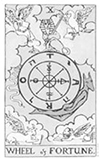
Invariably, The Wheel of Fortune card shows a wheel—often with eight spokes, a reference to the eight pagan holidays that mark the ever-turning cycles of life, death, and rebirth. The Wheel is also a symbol for the Sun’s path across the sky. Human or mythical figures may also be attached to the wheel.
The Waite deck shows a sphinx holding a sword at the top of the wheel, calmly watching as the karmic wheel revolves. Around the wheel are letters that spell “Rota,” a reference to the “Royal Road of the Tarot.” The ascending figure on the right is a jackal-headed man, called Hermanubis, who is known for keen eyesight. A serpent descending on the left side represents the Earth and the sexual energy that arises from it. Above and below, at the four corners of the card, are winged creatures holding open books. These correspond to the bull, the lion, the eagle, and the man, symbols of the fixed signs of the zodiac, Taurus, Leo, Scorpio, and Aquarius respectively. In the Christian tradition, these refer to Matthew, Mark, Luke, and John.
When The Wheel of Fortune appears in a reading, it means that something has been put in motion over which you now have little or no control. You are being forced to accept the action of the forces of destiny, to get in tune with them, and to align yourself with their aims. Generally, however, the outcome is considered favorable.
These forces already set in motion foretell of changing circumstances, usually for the better, beneficial changes that will promote your growth and advancement. Balance may be an issue if you are resisting change, but you now have no choice but to go along with whatever process is working in your life. The Wheel of Fortune is a reminder that every period of intense activity must be followed by a fallow time of rest and inactivity. Where you are in your own personal cycle will be shown by the other cards in the spread.
This card almost always heralds good fortune coming as a result of what you yourself have put into motion, even if you aren’t totally aware of what you have done to initiate the process. You may have applied for a new job, met a new person, begun a romance, decided to take a college course, or had a chance encounter that got the ball rolling—or the wheel turning. It means a new phase, possibly the need to make an important decision, or even a totally unexpected circumstance developing that will change your life.
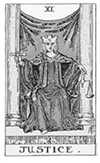
The Justice card usually depicts a female figure, robed, sometimes armored, and crowned. She holds an upright sword in one hand and in the other perfectly balanced scales. In some modern decks, she is either a nude figure with arms outstretched in absolute even balance, or she is shown standing between a large set of scales while holding a smaller set. Unlike the contemporary image of Justice as blindfolded, this Justice is open-eyed, suggesting that divine justice rather than the laws of man are at work here.
When the Justice card appears in a reading, it can indicate that an actual legal matter is pending or being considered. Whatever the situation, you must weigh many factors in order to make a reasoned and factual assessment, i.e., judgment, of the matter at hand. The Justice card warns you to receive guidance from your inner self, not to rely solely on human advisors. Also, it cautions prudence and care, the need to deliberate calmly and carefully before taking action or concluding an outcome. Depending on what other cards appear in the spread, a third party could come to your aid and help you get the fair outcome you deserve. This card can also represent anyone involved with the legal profession—a lawyer, a judge, witnesses, law enforcement officers, and the like.

The Hanged Man is a tantalizing figure. Usually a male, hanging upside down by one leg, The Hanged Man’s expression is serene, as if he is thoroughly enjoying his state. Suspended as he is by one foot, he appears to be engaged in a rather bizarre form of meditation or ritual.
In the Waite deck, The Hanged Man is shown hanging from a tree. Its roots are in the ground and the crosspiece that supports him sprouts leaves. Some authorities say this is the Tree of Life itself. Around The Hanged Man’s head is a golden halo, like the rays of the Sun. Yellow is the color of Mercury, the planet of the mind. Other decks picture only the horizontal beam, but it too has leaves on it, showing that it is living wood.
Many writers see The Hanged Man as a card of self-sacrifice and martyrdom, but others view this tantalizing card as voluntary surrender to the process of achieving enlightenment. It may require giving up superficial pleasures and trivial activities in pursuit of a more spiritual way of life. The word sacrifice derives from the Latin sacrāre, which means to make sacred. Therefore, The Hanged Man may represent a sacred pursuit.
This card can indicate that a new commitment to the development of the inner self is demanded. You might need to spend time alone in order to re-evaluate just what is and what is not important to you. It may be very difficult to let go of old patterns—a relationship, a job, a worldview, a lifestyle, or a group of other people—but letting go is essential to your continued growth.
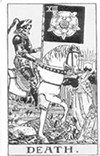
The Death card tends to frighten people who see it come up in a reading, but despite its grim depiction it symbolizes the transforming powers of life, death, and rebirth. Many decks picture a skeleton with a scythe grinning toothily and wearing a black hooded robe. The Waite deck pictures Death as a man in black armor riding a white charger, suggesting the perpetual movement of the cycles of life and death.
The knight carries a banner on which is embroidered the mystical white rose, symbol of pure and true love. The rose with five petals represents the five senses of material life combined with the immortality of the heart, or soul. Greeting the knight with hands outstretched in blessing or supplication is a priest figure wearing a mitered cardinal’s hat. Two children look on in awe. In the background, the Sun is rising, a sign of resurrection, over a body of water representing the unconscious realm.
The Death card in a reading rarely foreshadows a physical death. What it means is the end, or death, of a cycle. Whenever a stage in one’s life ends, there is a need for mourning. It is only the refusal to accept that something is ending—trying desperately to hold on to what is clearly over—that causes trouble. Employing cosmetic means to stave off the approach of age, for instance, is a useless effort to avoid the inevitable. What gives importance and meaning to this card is the querent’s acceptance of the change that cannot be avoided. Thus, in essence, the ultimate message of the Death card is the promise that new life follows disintegration.
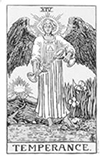
This lovely card often features a winged angel—male, female, or androgynous. In the Waite deck, the angel is standing in a stream bordered by flowers, with the rising Sun shining in the background. In most decks, the figure is pouring liquid—the elixir of life—from a golden vessel into a silver one in a continuous stream, suggesting the interplay of the material and spiritual worlds and the eternal flow of the waters of life. The word vessel is related to the great Mother Goddesses of antiquity, and the body is often referred to as the vessel of the soul. Thus, both the angelic figure and the cups are symbolic references to the feminine principle of cooperation, balance, harmony, receptivity, and creativity.
Temperance, as its name suggests, is about moderation in all things. When Temperance appears in a reading, depending on its position in the spread, you are being cautioned to have patience, which may be difficult under the circumstances. However, the circumstances of your situation will teach you to wait calmly when it seems like nothing is happening.
The person who receives Temperance in a reading is not in a position to hurry matters along. The only course is to sit and wait for things to move in their own time. The trick is to make the waiting constructive. This is one of the great lessons of the Zen masters. Learning to do nothing mindfully is a milestone on the spiritual path. It’s of vital importance to know that there are times when nothing can be done and nothing needs to be done. Therein lies the state of grace.

Many decks picture a medieval Christian-type devil, complete with horns, hooves, a hairy tail, and a pitchfork. Usually at the devil’s feet are two small, humanlike figures, one male and one female, with chains around their necks that are attached to the block upon which The Devil sits. However, it is important to note that the chains are loose and the people could easily slip them off, suggesting self-imposed limitations. Whatever form The Devil takes in various decks, he is usually pretty scary looking. Occasionally, he is batlike or stylized depending on the theme of the deck and its designer’s inclinations toward the figure.
The variety of illustrations implies widely differing opinions of the card’s meaning. For some, the devil is a creature of consummate evil; for others the devil is a mythical creature. Many psychologically oriented people see the devil as a symbol of human indulgence, ignorance, egotism, greed, and irresponsibility. Thus, the illustration appearing on the card represents a point of view as well as the traditional meanings associated with the card.
Superficially, The Devil appears to be one of the more alarming cards of the Major Arcana. However, he does not represent satanic forces with evil intent, and it is important to remember this when doing readings. He is the horned god of pagan times, connected to the fertility rites banned by the Church, which feared the power of pagan rituals, especially those including sexual activity.
When The Devil shows up in a reading, depending upon his position in the spread, he is telling you that you need to re-evaluate your relationship to material things, which are keeping you chained. It’s time to look at whatever is limiting you and holding you back from personal growth, especially abusive, obsessive, or harmful relationships. You are being called upon to confront your fears about financial security and social and material success—the things of this world. The Devil is a reality check that tells you to let go of old fears, hang-ups, inhibitions, and ways you manipulate others to satisfy your needs instead of taking responsibility for yourself in a positive manner. Whatever the situation, you are the only one who can change it. The two chained figures on the card represent bondage to the material realm. Their loose chains indicate your potential for attaining freedom by relinquishing obsessive ambition and excessive attachment to the things of this world.

The Tower usually depicts a stone tower of fortress-like construction, such as those still remaining from medieval times in Europe. The Tower is in the process of falling down or being destroyed, most often by fire or lightning.
Like the Death card and The Devil, The Tower tends to strike alarm and fear into anyone in whose reading it appears, and indeed many writers assign a fully negative meaning to this card. The Tower does not necessarily represent ruin and devastation, although its appearance usually does herald swift and dramatic change—sometimes shocking and extremely upsetting change.
It is important to keep in mind that the querent has usually brought the situation on herself by ignoring or denying that something is rotten and needs restructuring or deconstructing. Most likely, the querent is already well aware of a pressing need to make changes, but he or she is steadfastly refusing to take action. Then along comes a circumstance, such as losing a job or getting a divorce, having an accident or a financial setback, that forces the person to face reality.
The message of The Tower is that you must destroy the old structures before they destroy you, so you can become free. Otherwise, they may be shattered by seemingly outside influences (which you have actually created yourself). In the wake of the chaos, a new order will grow. What was unsound will come tumbling down. You can pick and choose among the rubble to decide what is worth saving, and from that, rebuild your life in accordance with who you truly are.

This lovely card usually portrays a nude female figure in or beside a pool of water, pouring from two jugs, one held in each hand. In the Waite deck, she kneels and pours the contents of one pitcher into the stream and the contents of the other into the ground, showing the connection between the two feminine elements: Earth and Water. The naked woman represents unveiled truth and purity. The jugs she holds contain the waters of life. Some of the water is being returned to the Source, some is being used to infuse the land with new life.
The background of this card always displays stars; often, one directly above the figure’s head is much larger than the others. Many decks show seven subsidiary stars, sometimes arranged to reflect the portal or two-pillar theme, sometimes set in a circle or a halo-like form around her. The stars sparkle above a pastoral setting—trees, mountains, birds, flowers.
The Star is a universal symbol of hope. Its appearance can signal the end of the travails represented by some of the earlier cards, symbolizing that a new and happier phase of life is coming into being. We see shooting stars as harbingers of good luck. From earliest times humans have been awed and fascinated by the star-spangled sky, the constellations, and the apparent motion of the bowl of the heavens.
The Star in a reading is like looking up at the bright starry sky on a clear night and seeing all the magnificence of the universe. It stimulates us to ponder the great potential of each and every human being for growth, inspiration, intuition, inner wisdom, and happiness.
Although The Star does not usually point to any specific planetary transit, as do some of the other Major Arcana cards, it does have a strong connection to astrology in general, for the zodiac signs relate to constellations. When The Star appears in a reading, it is a good time to have your horoscope read or to begin studying astrology yourself. A gate has opened for you to new possibilities. This card portends good fortune, creative inspiration, spiritual growth, help from unseen forces, and wishes come true. It marks a time of fulfillment.
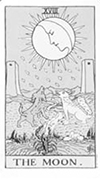
The Moon is a magical, mysterious card emblematic of the unconscious and the invisible realm of dreams, imagination, and psychic impressions. Usually the Moon occupies the top half of the card, sometimes shown in both its full and crescent phases with the crescent enclosed in the full circle. In the Waite deck, drops of water fall from the Moon, raining down on two canines, a dog and a wolf, who bay at the Moon. Two towers, one on either side, reflect the portal theme. At the bottom of the card is a pool or pond of water from which crawls a crab (symbol of the astrological sign Cancer, which is ruled by the Moon), crawfish, or lobster. The water suggests the Moon’s link with the tides, the Earth, the emotions, and the unconscious realm.
Astrologically, the Moon represents the soul, which is the link between spirit (Sun) and matter (Earth). The Moon is feminine: It symbolizes what we feel and how we respond. Therefore, it is emblematic of all that is receptive in human nature: the subconscious, the emotions, the instincts, and the automatic functions of the body. The lunar self is the channel for the flow of the universal, or divine, source, and as such, the Moon has great power. It affects everything and everyone on Earth, from the ocean’s tides to the moods and reproductive cycles of humans.
Therefore, when The Moon appears in a reading, it suggests that you should be paying more attention to your inner/lunar self. It advises you to illuminate your deepest nature. In its diffuse light, we can often see more clearly than in the glare of the Sun. The light of the Sun enables us to see the world around us, but the Moon allows us to illuminate what springs naturally from inside ourselves.
During the hours of night, our senses are more open and receptive to our inner spiritual harmony. When The Moon appears in a reading, it is time to attend to your dreams, feelings, instincts, and intuition.
Although traditionally The Moon card can indicate deceit and self-deception, these conditions are usually a result of ignoring your own inner promptings. If you get “taken”—especially emotionally—it’s because you were letting your rational mind override your feelings. The Moon card’s appearance also notifies you to take care of loose ends connected to the past, especially to your mother or other females.
The Moon is the symbol for the Goddess, whose three aspects represent the three faces of the great Triple Goddess. As the newborn crescent, the Moon is the maiden, the virgin—not chaste, but belonging to herself alone, not bound to any man. At the full Moon, she is the mature woman, sexual and maternal, giver of life. At the end of her cycle, the waning Moon about to turn dark represents the crone whose years have ripened into wisdom.
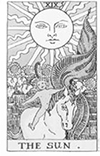
The Sun card features a blazing Sun, sometimes with a face, with sunbeams radiating out from it. Beneath the Sun, in the Waite deck, a smiling nude child is riding a white horse. Behind him, a banner unfurls, held up by a winged staff. In the background, huge sunflowers grow against a stone wall. The Sun’s planetary ruler is Leo, which is linked with children, pleasure, and creativity. The astrological Sun also rules the heart, the center of the body and the personality. The Sun card represents life itself, for the Sun gives life to everything on earth. The Sun suggests vitality, confidence, achievement, ego-attainment, and success in all endeavors.
When The Sun card appears, it is an indication that your past work is now bearing fruit, a concept that is symbolized by the child or children. Along with The Moon, it implies the union between the unconscious realm of creativity (Moon) and the conscious realm of manifestation (Sun). Whether the birth represented is a biological child or a creative project, the outcome is a happy one. It is a time when good things come into your life—success, optimism, achievement, health, general good fortune, and happiness.
When The Sun turns up, it brightens any negative cards in the spread—no matter where The Sun appears in the spread. His influence is always beneficial, suggesting prosperity, enthusiasm, honors, public recognition, and attainment. You are happy to be alive because you feel it is the dawning of a new day. Any special efforts or ventures, such as taking a test or making a presentation, will turn out favorably.
In the wake of the demise of the great Mother Goddess as the sole divinity, the Sun, which represents the masculine principle, came to be worshipped as the central deity in many cultures. The ancient Egyptians, after eons of a pantheon of goddesses and gods, under the leadership of the pharaoh Akhenaten, were persuaded, albeit reluctantly, to accept a single god—known as Ra, Amun-Ra, or Aten (all of which were names for the Sun)—which Akhenaten believed was the god of all gods. The Greeks called their Sun god Helios, whom the Romans named Apollo.

The Judgment card visually seems rather negative. In the Waite deck, a winged figure, whom some call the angel Gabriel, emerges from a cloud and blows a trumpet. Beneath him are several nude figures of men and women looking up, hearing the trumpet’s blast. Their arms are outstretched, and they seem to have risen from coffins or the earth itself. Their expressions reveal awe tinged with fear.
Of all the allegorical symbolism of the Major Arcana, this is the most purely Christian, suggesting the feared Day of Judgment, when God will judge all souls and apportion out rewards or punishments accordingly. However, this is not a totally Christian idea; the Egyptians and other cultures also expressed the notion of the soul being judged. The goddess Maat, for instance, weighs the soul against her Feather of Truth. Whether seen from a Christian point of view (which these medieval images represent) or from a universal one, the idea behind the symbols is that of an awakening.
When the Judgment card appears, what is being awakened is a sense of a higher self within. Sometimes the card coincides with a person turning away from a traditional set of beliefs toward one that better suits his or her personal philosophy of life. Judgment represents the end of something—an old way of life, a cycle that is finished. It is a time to seek new direction, to make adjustments that reflect who your truly are—perhaps by breaking away from your conventional way of life and believing.
Generally speaking, this is a positive card symbolizing regeneration and rebirth into wholeness after a period of confusion and a sense of confinement (shown by the coffins). You may have been feeling “dead” in your old life. When Judgment appears, you have the unique opportunity to relive, to enliven yourself and your environment by making the appropriate changes. What is ending is doubt and indecision, depression and despair, fear and inhibition. It’s a time of new freedom to be yourself.

In many decks, The World card shows a young woman, sometimes nude or wearing a long scarf. The scarf covers her genitals but leaves her breasts bare. In each hand, she holds a double-ended wand that points both upward and downward, suggesting, “As above, so below.” In the Waite deck, she is surrounded by an oval-shaped wreath.
As with The Wheel of Fortune card, to which The World is related, the four corners of the card feature a bull, a lion, an eagle, and a man—representing the four fixed signs of the zodiac: Taurus, Leo, Scorpio, and Aquarius. These elemental figures also depict the four directions.
This is the last numbered card of the Major Arcana. It represents balance and support by unseen forces and symbolizes the end of the spiritual journey begun by The Fool. To embark upon the spiritual journey is to invite unseen forces to interact with us. These creative energies manifest in many ways, and often serve as guides. Guides bring us into grace and show the way. To encounter a guide—and they come in many guises—is to enter another realm, a place of great powers and, sometimes, great secrets. This realm belongs to the invisible world, although its denizens can, like angels, assume human or animal form. To interface with this world is to be impacted in a way that is life-changing. With guides, we enter a world of supreme power—not the power of the material world but of the invisible order that supports and nourishes our world and our lives here. It is the realm of the sacred.
When The World card appears in a reading, it is a signal that you have been guided to the successful conclusion of your spiritual journey. At this, the final stage, you will receive what is rightfully yours because you have earned it. Now you are and feel whole, complete. You are refreshed from your long journey and ready to begin anew at a higher level.